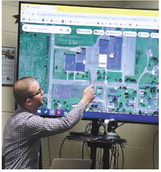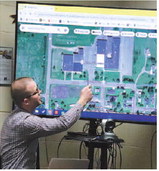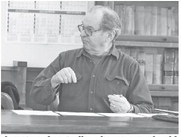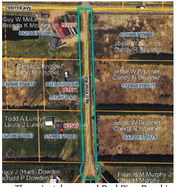County backtracks on premium pay changes
Taylor County won’t drastically change the additional pay given to highway department workers who take on additional duties.
Under personnel policy changes connected with the reevaluation of county employees, the county was set to cut premium pay given to staff for bridge inspection, working crew leaders, equipment operators and shop technicians.
Highway Commissioner Ben Stanfley disagreed with the proposed changes and on Monday went to the personnel committee on behalf of his department employees.
According to Stanfley, the county highway department patrolman positions were about 18% below market rates under the wage study done for the county. Under the new pay policy, the patrolman positions jump a pay grade which helps makes them more competitive, but as part of that recommendation, the additional pay for doing tasks was proposed to be cut along with eliminating language from the policy saying the rates would increase automatically with cost of living adjustments to wages for the county.
Stanfley noted the increased wages for those duties are only paid out when the employees are doing that task. For example, the additional $5.36 per hour paid to the badge inspectors is only when they are doing inspections, likewise the $2.68 per hour additional wages for running the specialized heavy equipment used by the department is only when the staff member is assigned to be the operator of that equipment.
Stanfley explained that his system saves the county money over the course of a year because in other times those employees revert to their patrolman wages. He said in other, larger counties it is more typical to see these as separate positions with year-round higher wages.
“This is why I feel we should increase the pay as the cost of living increases,” Stanfley said.
See COUNTY on page 8 He said reducing the premium wages and taking away increases in the future would reduce the county’s competitiveness. “I don’t think it is fair and I don’t think it is the right thing to do,” he said.
Committee chairman Chuck Zenner said he disagreed with cutting the premium wages, but suggested the premium amounts could be reviewed every five years or so to bring them in line.
Stanfley noted that prior to him bringing it to the county to be adjusted four years ago, the premium amounts had not been adjusted. “It is to the county’s advantage to have the pay scale this way,” he said.
Committee members Scott Midlbrand questioned how often during a 40-hour week the premium pay would typically be applied. Stanley said it depends on what tasks they are doing. The bulk of the usage is during the summer months when the road crews are busy with a variety of tasks including things like line painting and culvert replacement which generate revenue for the county.
“We are not talking big numbers here,” Stanfley said. The total payout for premium pay in the department for an entire year was estimated to be below $10,000.
Committee member Lynn Rosemeyer said it was a small amount of money overall compared to the potential negative morale impacts reducing the pay rates would bring. In the end, committee members approved the policy change, calling for the bridge inspection to stay at $5.36 per hour, the working crew leader to stay at $4.82 per hour, the equipment pay to stay at $2.68 per hour and only the shop tech premium pay to be reduced from $3.21 per hour to $2 an hour. This last change was to maintain a wage difference between when a patrolman helps in the shop versus the mechanics who are in the shop full time.
In addition, the committee approved changing the policy back to having annual cost of living increases for the rates.
Vehicle use policy
Committee members called on the county to backtrack from a one size fits all policy for mandating GPS tracking devices in all the county vehicles.
Stanfley noted that during prior discussion at the county board regarding the vehicle use policy it was incorrectly stated that the highway department already had monitoring on its vehicles. Only a few of the county’s patrol trucks have GPS monitors.
Stanfley said most of the highway department’s 56 trucks do not have the GPS trackers nor do the 30 other pieces of road equipment. He said the annual cost of installing and paying for the service to monitor the trucks would be about $13,440 in the first year. For the other equipment, it would cost about $17,700 the first year due to installation expenses and $7,200 a year after that in ongoing monitoring costs. Altogether, for just the highway department, this is a bill of $31,140 in the first year and $20,640 in future years.
Stanfley said this works out to be about the same cost as buying a new pickup truck every other year. He said if the county were to install it only on the 22 patrol trucks it would be about $5,808 per year.
Stanfley proposed changing the policy language to give oversight committees, whether at the departmental or the finance and personnel levels, the authority to decide if they should install the monitoring devices.
“It is a lot of money,” Rosemeyer said, in support of scaling back on the monitoring requirement.
For Zenner, the challenge is that every oversight committee has a different way of doing things and they could end up with the policy being applied in some areas and not others. Stanfley said this is why he proposed it to be committees, since it would allow personnel to require the monitoring if that group felt it was necessary to implement. “Do we really need to do this?” Rosemeyer said, noting she struggled with the policy.
Mildbrand said that when the policy was proposed, there was no expectation that it was going to be on the equipment. “It was just going to be on trucks,” he said.
He also noted the primary goal was about ensuring employee safety, giving the example of the human services department going out on home visits and the county being able to find them and know where they are.
Board chairman Jim Metz also raised that there had been concerns with vehicles not being used properly and the need for accountability.
Human Resources director Nicole Hager noted that she was handed the project to do when she started with the county 2.5 years ago and has been working on it since then.
Mildbrand said he could see value in some departments such as human services, forestry and the patrol trucks having them because of the chances of being broken down in areas without cellular phone service. Hager agreed, noting she is working with a claim from an employee who was injured while working in Perkinstown.
Stanfley said they needed to rework the policy to allow for more flexibility and common sense.
In the end, committee members gave their approval to changes to allow committees to decide which vehicles should be monitored and have those committees give a list to the county’s administrative coordinator by September 1 each year.
In other business, committee members: Gave approval to create a new youth justice position in the human services department intake and ongoing services. Director Suzanne Stanfley told committee members that the position was needed to handle continuing backlogs and a growing caseload. In 2022 there were 76 total intakes, in 2023 there were 65 total intakes and as of August 2024 there have been 75 intakes with the department on track to have 101 intakes by the end of the year. She also reported the department has 32 youth in out of home care, which is the highest the department has seen. Stanfley presented comparisons that show the caseload of existing staff in the department compared to what the state says is the acceptable amount. Across the board, Taylor County exceeded the recommended caseloads. Stanfley said she hopes the county will be able to reduce out of home placement which will allow the grant funding from the sate to go further and potentially help pay for staff expense. As for now, the position is being proposed as being part of the existing human services budget with the potential that it could have a levy impact in future budget years. “It certainly looks like we need it,” Zenner said. The creation of the position had also been approved by the human services committee.




